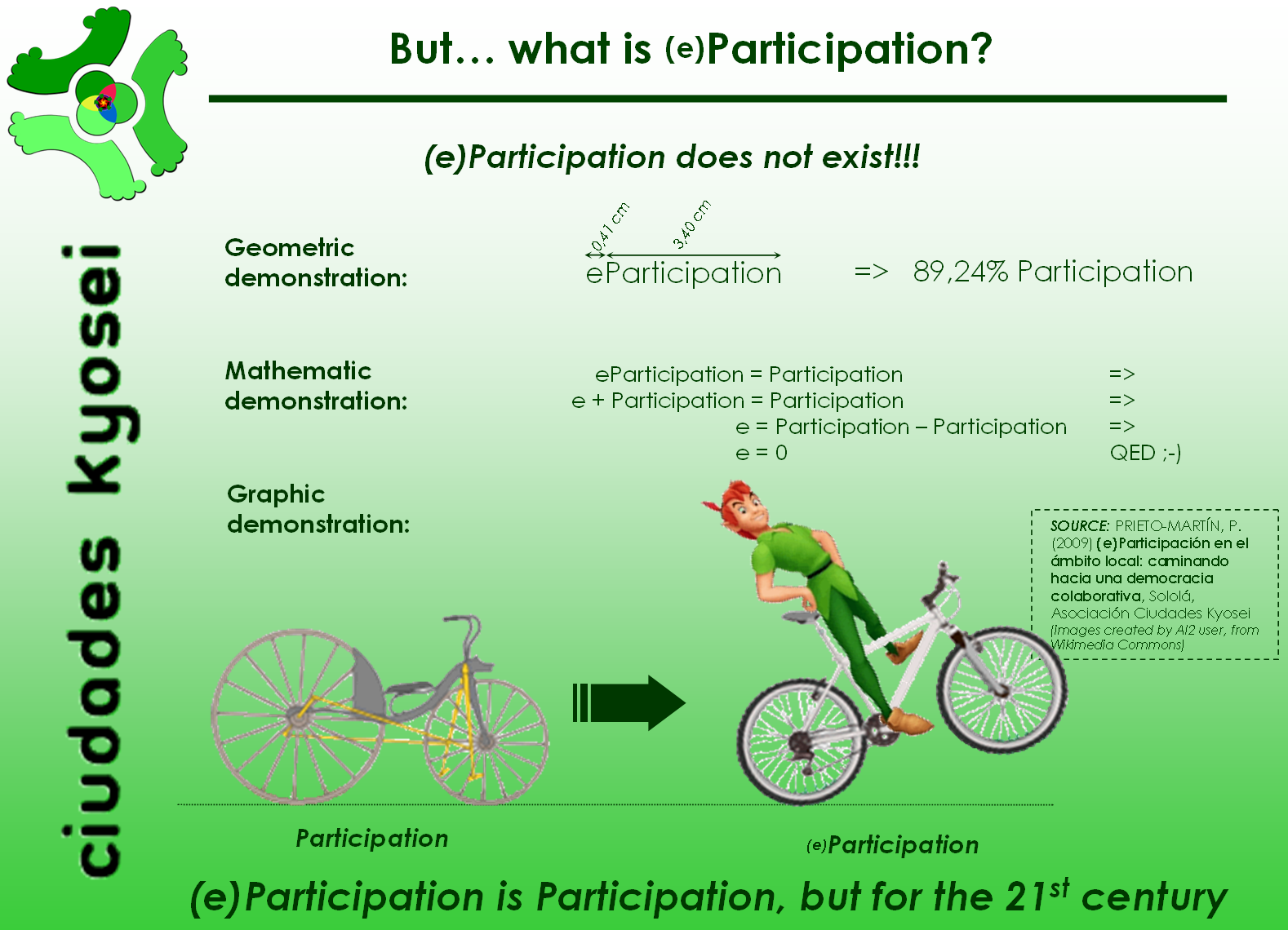Images for reflection (II): “So… what is (e)participation?”
10. September 2009 – 08:25 by Asociacion Ciudades Kyosei
Again: everybody is invited to reflect.
(this image was introduced and partly explained as part of the discussion on the previous post: Impressions of the eDem 09 conference in Vienna). Reproduced below:
[ Well, I’m not sure if the “e-” should be dropped. Dropping could be too radical, and the e actually “adds” some meaning.
But I’m also not happy with the suggestion from Peter: to consider Participation and e-Participation as two very related things, but somehow also different: e-Participation understood as an extra channel for participation. Thus, we would need to be able recognize how to combine both and when to use each of them.
I think what is needed is to correctly relate the “e-” side to the “Participation” side of the mix.
And this means:
1. Recognize the diminishing meaning of the e- part of the term. In the next years the “e-” will surely just disappear. In the same way that we no longer speak about e-Banking, because we assume that any “Banking” worth its name MUST integrate an “e-” infrastructure that empowers it… citizen Participation without an “e-” backing will simply be a contradiction in terms.
It’s the same case with “electric lighting” too. “Electric lighting” was probably an expression profusely used at the beginning of the XX Century: but now, most of the time, we no longer explicitly name it “electric” -we just assume lighting “is” electric, since gaslighting belongs to our history.
This is the reason why our association, since years, uses the alternative “(e)Participation” term, that emphasizes the fading significance of the “e”.
2. But at the same time that the “(e)” significance fades away… it gains more and MORE importance.
It is clear that the “e” doesn’t change the fundamental meaning of “participation”, that it doesn’t change its essence.
[Sadly enough, most “experts” on e-Participation still do not realize this. They have traditionally considered (and “sold”) e-Participation as something essentially different from Participation. And they have done this because, in most cases, they had NO idea what the traditional “Participation” is about, and what are the problems and dynamics associated with it. And they weren’t willing to read the thousands of socio-political papers devoted to it ![]() ].
].
Anyway, let’s go back: we were saying that the diminishing “(e)” does not change the nature of Participation.
But as time goes by, it will completely change the way Participation works. And it will also change our notions on what is possible to attain through Participation (and thus: through Democracy).
Again, the (e)Banking example is very illustrative. Using computers, networks and the Internet for banking and finance revolutionized what could be done. Not sure if those changes were for good… but the fact is that (e)banking, without changing the very nature of banking, radically changed the way banking works. ]
[This second “Image for reflection” tries to express in a vivid an humorous way what we have just explained.]
Tags: eParticipation, Participation



3 Responses to “Images for reflection (II): “So… what is (e)participation?””
By Bengt Feil on Sep 15, 2009
Well done!
I especially like the mathmatic demostration. Right down my alley of humour.
By Sabrina Franceschini on Sep 21, 2009
Hi all! I agree the most of remarks of this post, in particular in my professional context I’m trying to connect the practitioner of traditional participation with the “E” world…I can say that the lack of trust in the other is bidirectional…We need, all, to have a neutral and modest approach because we ( who is involved in eParticipation projects) could give some new opportunity to integrate and enriche, sometime very goods, the results in the traditional way to involvment of citizens.
By Csaba on Sep 21, 2009
Personally, and I do think, the traditional participation practicioners strongly agree with the basics of this article. E- was sold out. That is the key message, and it has become obvious, such as the gap between practicioners and the e(xperts). In the evolution of technology, it is clear, that how the language of science behaves, it is not supporting knowledge transfer - rather puts it into a closed box. It’s identity is the difficultyness of understanding. Why should be other way? Since most of our scientist has come out of traditional universities, where knowledge meant the skill to preserve and keep your knowledge in house rather than sharing it.
Hopefully, this new culture demistifying e-s brakes these myths, and at least for the everyday citizen, it will be no doubt, that the letter (e) is not an add(e)d value, but something, which is reflecting some dark age of communication science’s. How many extra papers do we have to print becasue of this and similar like logical dead-ends? We shall at least now recognize, that if we, humans are electric humans (although quite weak), there is no need to distract our universe by the e term. Now obviously it is connecting everybody - wheter uses e or not, we participate in the same space, which is still infinite..